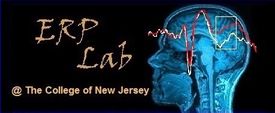Welcome to the ERP Lab at The College of New Jersey
What is an ERP?
Event-Related Potentials (ERPs) are electrical activity of the brain (Electroencephalogram or EEG) that are time locked to an “event,” such as the presentation of a word. We record multiple trials of the same event and average the activity to extract brain activity signal from the background neuronal activity. For example, we can have people learn a list of words. Then, we can test people’s memory while we record EEG. When we average all the old words to form an ERP for old words and then average all the new word trials to form an ERP for new words, we can clearly see that the brain is more active when people see an old  (studied) word. The figure to the right displays ERPs elicited by old (red line) and new (black line) words at the left parietal electrode site. You can see memory-related (old vs. new) ERP differences 500 to 800 ms after the presentation of the word.
(studied) word. The figure to the right displays ERPs elicited by old (red line) and new (black line) words at the left parietal electrode site. You can see memory-related (old vs. new) ERP differences 500 to 800 ms after the presentation of the word.
History of the Lab
In 1992, Leynes started collecting ERP data on very old Grass Instruments Amplifiers at a University of Georgia lab. A few years later he built a new ERP lab at the University of Georgia. It took about a year to complete and learn how to use the equipment. So, it became fully functional in 1996. He completed his dissertation work in that lab and conducted a few studies during his post-doctoral fellowship.
In the fall of 1998, he accepted a position here (at the College of New Jersey). The College provided enough start up funds to build an ERP lab at TCNJ. The first lab was built by the end of Spring semester 1999 in Forcina 405. In the summer of 2001, the lab moved to the new Social Sciences Building. The lab used Contact Precision Instruments equipment capable of measuring 32 channels of EEG until the Fall 2019 semester.
The lab currently uses a Comupedics Neuroscan Grael EEG amplifier. We measure ERP activity while people complete memory experiments to learn more about memory and how memory is represented in the brain (see our Research page for more detailed information about current lab experiments).

